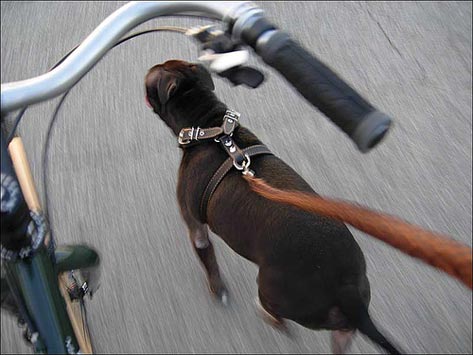

Many people with arthritis will testify that they feel more pain during cold weather. The problem is doctors have not found a reason for why this is. We assume that part of the cause is the drop in air pressure, which can allow the tissues to swell, or the effect that cold has on the muscles; a stiffening that can be uncomfortable even for those who do not suffer from joint issues. The same holds true for animals that suffer from the effects of arthritis. We can see that they are feeling more pain when the temperatures dip, but doctors cannot tell us why this is happening.
First, what is arthritis? The most common type, for both humans and animals, is the type that is related to age, or wear and tear. Called osteoarthritis, damage begins in the cartilage of the joint. Cartilage is a firm but flexible connective tissue that is found between the bones within the joints – including the joints of the knees, hips, and so on.
When the cartilage in the joints begins to erode over an animal’s life, or when it is damaged due to injury to the joint, the bones in the joint are allowed to come into direct contact with each other, eventually resulting in the erosion of and further damage to the bone. The joints most likely to be affected are the weight bearing joints; those in the pelvis, knees, ankles and spine.
What may begin as mild discomfort for the dog over time becomes increasingly painful, and this is especially true for animals that are overweight, as the weight places excess pressure on the bones in the joints.
Although arthritis is a progressive disease without a cure, some of the pain can be alleviated; in some cases, the disease’s progress can even be slowed. Treatment plans often include a healthy, reduced-calorie diet, therapeutic exercise, massage, and anti-inflammatory medications and/or supplements. For some dogs, alternative therapies may also be considered.
One of the best things you can do for your dog right now is to make sure you have him or her on a weight maintenance diet, since extra weight places a lot of extra pressure on the already stressed joints. If your dog is already overweight, you will need to start a weight loss diet.
However, before you make any drastic food changes -- either in type or amount -- you should check with your veterinarian. But do it as soon as possible. The longer you allow your dog to remain overweight, the worse the arthritic pain will be for her. Given enough time, your dog will eventually not be able to move around except through a haze of excessive pain.
Needless to say, feeding your dog a quality, low-calorie, low-fat diet will help her to shed pounds and keep them off. There are even plenty of specially formulated dog foods designed for improved joint function in older dogs. Some dog food companies will even send free samples. Do your research, talk to your veterinarian and try samples of different specialty foods until you find the perfect one for your dog.
Additionally, keep in mind that major changes in the type of food may upset your dog, and that some formulas may not be appropriate for your dog’s age and health. Always check with your veterinarian first.
If possible, it is best to take your dog out for regular activity (a little each day or at least four days a week) at a dog friendly park or dedicated dog park. Start out with short walks around the park and work up from there. If you do not have that option, either because of availability or because of weather, there are an increasing number of exercise centers that are being opened for dogs around the country. Most have swimming pools (assuming they're not already frozen over), a great exercise for arthritic dogs since it is a non-weight bearing activity.
Use your preferred Internet search engine (Yahoo, Google, Dogpile, Bing, etc.) to look for "dog gyms" and "dog activity centers" in your area. Another alternative is to buy your own treadmill to keep at home so that you can exercise your dog at the convenience of your own schedule and in the comfort of your home. Even regular walks up and down the stairs in your building or home are a form of exercise that will benefit your dog (and you).
It is generally agreed that too little exercise is worse than none at all. If you are going to start an exercise plan with your dog, you will have to stick with it, and the more the better. Also, choose exercises that do not stress the joints too much, or you will have a reluctant dog who is too sore to exercise the next day.
There are some medications that may help your dog, depending on the severity of the arthritis. Your veterinarian can prescribe an anti-inflammatory or corticosteroid drug for your dog to reduce inflammation. There are also injectable medications for the promotion of cartilage repair and protection. Dietary supplements generally do not require a prescription. In fact, the most common ones, glucosamine and chondroitin sulfate, are widely used by humans for the management of joint pain.
While supplements are not designed or marketed as painkillers, they do work to repair and reform the cartilage in the joints. For example, glucosamine and chondroitin give the chondrocytes, the cartilage-forming cells, the elements they need to manufacture new cartilage and repair damaged cartilage. These supplements take some time to begin making an obvious effect, however, and need to be given for life to continue to be effective.
Other supplements that have proven useful for arthritis include green-lipped mussel extract, omega-3 fatty acids, MSM (methyl-sulfonyl-methane), ASU, and SAMe. Again, and as always, check with your veterinarian before giving your dog anything new and untried. Even simple supplements might complicate an undiagnosed, underlying health condition.
Along with the growth and acceptance of alternative healing techniques for humans, there has been a subsequent rise in the availability of alternative care for dogs, too. Therapies such as massage, acupuncture and physical therapy can be very beneficial for your dog. In some cases, such as with massage or herbal baths, you can provide the care at home. There may be pet massage classes in your area with instructors that teach the specifics of animal massage, or you can do your own research with books written on the topic – either bought from a bookstore or borrowed from a library.
Take note that it is important to know your dog well and know the correct techniques to use before attempting massage. An incorrectly placed “squeeze” could send your dog into spasms of pain and result in a bite on your end.
As before, use your favorite Internet search engine to find local classes or healers that work with dogs.
Keeping your dog comfortable and warm is important during the cold season. Providing your dog with a well-padded bed in a warm indoor location or placing a heated blanket (make sure it’s pet safe) in his bed can make all the difference in his outlook. Special equipment, such as ramps to go up and down stairs or onto higher furniture, can allow your dog the ability to move freely throughout the house and to go in and out of the house easier.
Clothing can also help to keep the joints warm. Wrap your dog in a specially designed dog sweater, or alter one of your old sweaters or sweatshirts to fit your dog.
Image: Rodrigo / via Flickr
 The Hype of Hypoallergenic Pets
By Yahaira Cespedes
Allergy sufferers dread spring
The Hype of Hypoallergenic Pets
By Yahaira Cespedes
Allergy sufferers dread spring
 Biking With Your Dog…Safely
Are you a biker who feels guilty every time
Biking With Your Dog…Safely
Are you a biker who feels guilty every time
 Top 5 DIY Halloween Costumes for Your Dog
Best Homemade Costume Ideas for Dogs
There a
Top 5 DIY Halloween Costumes for Your Dog
Best Homemade Costume Ideas for Dogs
There a
 Aggressive Behavior in Dogs (and Cats): How to Handle this Tough Situation
By T. J. Dunn, Jr., DVM
The following essa
Aggressive Behavior in Dogs (and Cats): How to Handle this Tough Situation
By T. J. Dunn, Jr., DVM
The following essa
 6 Exercises You Can Do With Your Dog
By Andrew Daniels
Man’s best friend m
6 Exercises You Can Do With Your Dog
By Andrew Daniels
Man’s best friend m
Copyright © 2005-2016 Pet Information All Rights Reserved
Contact us: www162date@outlook.com